Archive
Readability of anonymous inner classes and lambda expressions
The available evidence on readability is virtually non-existent, mostly consisting of a handful of meaningless experiments.
Every now and again somebody runs an experiment comparing the readability of X and Y. All being well, this produces a concrete result that can be published. I think that it would be a much more effective use of resources to run eye tracking experiments to build models of how people read code, but then I’m not on the publish or perish treadmill.
One such experimental comparison of X and Y is the paper Two N-of-1 self-trials on readability differences between anonymous inner classes (AICs) and lambda expressions (LEs) on Java code snippets by Stefan Hanenberg (who ran some experiments on the benefits of strong typing) and Nils Mehlhorn.
How might the readability of X and Y be compared (e.g., Java anonymous inner classes and lambda expressions)?
If the experimenter has the luxury of lots of subjects, then half of the subjects can be assigned to use X and half to use Y. When only a few subjects are available, perhaps as few as one, an N-of-1 experimental design can be used.
This particular study is worth discussing because it appears to be thought out and well run, as well as illustrating the issues involved in running such experiments, not because the readability of the two constructs is of particular interest. I think that developer choice of anonymous inner classes or lambda expressions is based on fashion and/or habit, and developers will claim the construct they use is the most readable one for them.
The Hanenberg and Mehlhorn study involved two experiments, using a N-of-1 design. In the first experiment task, subjects saw a snippet of code and had to count the number of parameters in either the anonymous inner class or the lambda expression (whose parameters were either untyped or typed); in the second experiment task subjects had to count the number of defined parameters that were used in the body of the anonymous inner class or lambda expression. English words were used for parameter names.
Each of the eight subjects saw the same set of randomly shuffled distinct 600 code snippets. The time taken to answer and correct/incorrect answer status were recorded. The snippets varied in the number of parameters and kind of construct; for task 1: 0-4 parameters, 3-kinds of construct, repeated 40 times, giving  distinct snippets; for task 2: 0-3 parameters used out of 3 parameters, 3-kinds of construct, repeated 50 times, giving
distinct snippets; for task 2: 0-3 parameters used out of 3 parameters, 3-kinds of construct, repeated 50 times, giving  distinct snippets.
distinct snippets.
The first task requires subjects to locate the definition of the construct, count the number of parameters, and report the count. The obvious model is different constructs require different amounts of time to locate, and that each parameter adds a fixed amount to the response time; there may be a small learning component.
Fitting a simple regression model shows (depending on choice of outlier bounds) that averaged over all subjects each parameter increased response time by around 80 msec, and that response was faster for lambda expressions (around 200 msec without parameter types, 90 msec if types are present); code+data. However, the variation across subjects had a standard deviation that was similar to these means.
The second task required subjects to read the body of the code, to find out which parameters were used. The mean response time increased from 1.5 to 3.7 seconds.
I was not sure whether to expect response time to increase or decrease as the number of parameters used in the body of the code increased (when the actual number of parameters is always three).
A simple fitted regression model finds that increase/decrease behavior varies between subjects (around 50 msec per parameter used); code+data. I am guessing that performance behavior depends on the mental model used to hold the used/not yet used information.
The magnitude of the performance differences found in this study mimics that seen in most human based software engineering experiments, that is, the impact of the studied construct is very small.
Widely used programming languages: past, present, and future
Programming languages are like pop groups in that they have followers, fans and supporters; new ones are constantly being created and some eventually become widely popular, while those that were once popular slowly fade away or mutate into something else.
Creating a language is a relatively popular activity. Science fiction and fantasy authors have been doing it since before computers existed, e.g., the Elf language Quenya devised by Tolkien, and in the computer age Star Trek’s Klingon. Some very good how-to books have been written on the subject.
As soon as computers became available, people started inventing programming languages.
What have been the major factors influencing the growth to widespread use of a new programming languages (I’m ignoring languages that become widespread within application niches)?
Cobol and Fortran became widely used because there was widespread implementation support for them across computer manufacturers, and they did not have to compete with any existing widely used languages. Various niches had one or more languages that were widely used in that niche, e.g., Algol 60 in academia.
To become widely used during the mainframe/minicomputer age, a new language first had to be ported to the major computers of the day, whose products sometimes supported multiple, incompatible operating systems. No new languages became widely used, in the sense of across computer vendors. Some new languages were widely used by developers, because they were available on IBM computers; for several decades a large percentage of developers used IBM computers. Based on job adverts, RPG was widely used, but PL/1 not so. The use of RPG declined with the decline of IBM.
The introduction of microcomputers (originally 8-bit, then 16, then 32, and finally 64-bit) opened up an opportunity for new languages to become widely used in that niche (which would eventually grow to be the primary computing platform of its day). This opportunity occurred because compiler vendors for the major languages of the day did not want to cannibalize their existing market (i.e., selling compilers for a lot more than the price of a microcomputer) by selling a much lower priced product on microcomputers.
BASIC became available on practically all microcomputers, or rather some dialect of BASIC that was incompatible with all the other dialects. The availability of BASIC on a vendor’s computer promoted sales of the hardware, and it was not worthwhile for the major vendors to create a version of BASIC that reduced portability costs; the profit was in games.
The dominance of the Microsoft/Intel partnership removed the high cost of porting to lots of platforms (by driving them out of business), but created a major new obstacle to the wide adoption of new languages: Developer choice. There had always been lots of new languages floating around, but people only got to see the subset that were available on the particular hardware they targeted. Once the cpu/OS (essentially) became a monoculture most new languages had to compete for developer attention in one ecosystem.
Pascal was in widespread use for a few years on micros (in the form of Turbo Pascal) and university computers (the source of Wirth’s ETH compiler was freely available for porting), but eventually C won developer mindshare and became the most widely used language. In the early 1990s C++ compiler sales took off, but many developers were writing C with a few C++ constructs scattered about the code (e.g., use of new, rather than malloc/free).
Next, the Internet took off, and opened up an opportunity for new languages to become dominant. This opportunity occurred because Internet related software was being made freely available, and established compiler vendors were not interested in making their products freely available.
There were people willing to invest in creating a good-enough implementation of the language they had invented, and giving it away for free. Luck, plus being in the right place at the right time resulted in PHP and Javascript becoming widely used. Network effects prevent any other language becoming widely used. Compatible dialects of PHP and Javascript may migrate widespread usage to quite different languages over time, e.g., Facebook’s Hack.
Java rode to popularity on the coat-tails of the Internet, and when it looked like security issues would reduce it to niche status, it became the vendor supported language for one of the major smart-phone OSs.
Next, smart-phones took off, but the availability of Open Source compilers closed the opportunity window for new languages to become dominant through lack of interest from existing compiler vendors. Smart-phone vendors wanted to quickly attract developers, which meant throwing their weight behind a language that many developers were already familiar with; Apple went with Objective-C (which evolved to Swift), Google with Java (which evolved to Kotlin, because of the Oracle lawsuit).
Where does Python fit in this grand scheme? I don’t yet have an answer, or is my world-view wrong to treat Python usage as being as widespread as C/C++/Java?
New programming languages continue to be implemented; I don’t see this ever stopping. Most don’t attract more users than their implementer, but a few become fashionable amongst the young, who are always looking to attach themselves to something new and shiny.
Will a new programming language ever again become widely used?
Like human languages, programming languages experience strong networking effects. Widely used languages continue to be widely used because many companies depend on code written in it, and many developers who can use it can obtain jobs; what company wants to risk using a new language only to find they cannot hire staff who know it, and there are not many people willing to invest in becoming fluent in a language with no immediate job prospects.
Today’s widely used programmings languages succeeded in a niche that eventually grew larger than all the other computing ecosystems. The Internet and smart-phones are used by everybody on the planet, there are no bigger ecosystems to provide new languages with a possible route to widespread use. To be widely used a language first has to become fashionable, but from now on, new programming languages that don’t evolve from (i.e., be compatible with) current widely used languages are very unlikely to migrate from fashionable to widely used.
It has always been possible for a proficient developer to dedicate a year+ of effort to create a new language implementation. Adding the polish need to make it production ready used to take much longer, but these days tool chains such as LLVM supply a lot of the heavy lifting. The problem for almost all language creators/implementers is community building; they are terrible at dealing with other developers.
It’s no surprise that nearly all the new languages that become fashionable originate with language creators who work for a company that happens to feel a need for a new language. Examples include:
- Go created by Google for internal use, and attracted an outside fan base. Company languages are not new, with IBM’s PL/1 being the poster child (or is there a more modern poster child). At the moment Go is a trendy language, and this feeds a supply of young developers willing to invest in learning it. Once the trendiness wears off, Google will start to have problems recruiting developers, the reason: Being labelled as a Go developer limits job prospects when few other companies use the language. Talk to a manager who has tried to recruit developers to work on applications written in Fortran, Pascal and other once-widely used languages (and even wannabe widely used languages, such as Ada),
- Rust a vanity project from Mozilla, which they have now
abandonedcast adrift. Did Rust become fashionable because it arrived at the right time to become the not-Google language? I await a PhD thesis on the topic of the rise and fall of Rust, - Microsoft’s C# ceased being trendy some years ago. These days I don’t have much contact with developers working in the Microsoft ecosystem, so I don’t know anything about the state of the C# job market.
Every now and again a language creator has the social skills needed to start an active community. Zig caught my attention when I read that its creator, Andrew Kelley, had quit his job to work full-time on Zig. Two and a-half years later Zig has its own track at FOSEM’21.
Will Zig become the next fashionable language, as Rust/Go popularity fades? I’m rooting for Zig because of its name, there are relatively few languages whose name starts with Z; the start of the alphabet is over-represented with language names. It would be foolish to root for a language because of a belief that it has magical properties (e.g., powerful, readable, maintainable), but the young are foolish.
Growth in number of packages for widely used languages
These days a language’s ecosystem of add-ons, such as packages, is often more important than the features provided by the language (which usually only vary in their syntactic sugar, and built-in support for some subset of commonly occurring features).
Use of a particular language grows and shrinks, sometimes over very many decades. Estimating the number of users of a language is difficult, but a possible proxy is ecosystem activity in the form of package growth/decline. However, it will take many several decades for the data needed to test how effective this proxy might be.
Where are we today?
The Module Counts website is the home for a project that counts the number of libraries/packages/modules contained in 26 language specific repositories. Daily data, in some cases going back to 2010, is available as a csv 🙂 The following are the most interesting items I discovered during a fishing expedition.
The csv file contains totals, and some values are missing (which means specifying an ‘ignore missing values’ argument to some functions). Some repos have been experiencing large average daily growth (e.g., 65 for PyPI, and 112 for Maven Central-Java), while others are more subdued (e.g., 0.7 for PERL and 3.9 for R’s CRAN). Apart from a few days, the daily change is positive.
Is the difference in the order of magnitude growth due to number of active users, number of packages that currently exist, a wide/narrow application domain (Python is wide, while R’s is narrow), the ease of getting a package accepted, or something else?
The plots below show how PyPI has been experiencing exponential growth of a kind (the regression model fitted to the daily total has the form  , where
, where  is the number of days since 2010-01-01; the red line is the daily diff of this equation), while Ruby has been experiencing a linear decline since late 2014 (all code+data):
is the number of days since 2010-01-01; the red line is the daily diff of this equation), while Ruby has been experiencing a linear decline since late 2014 (all code+data):

Will the five-year decline in new submissions to Rubygems continue, and does this point to an eventual demise of Ruby (a few decades from now)? Rubygems has years to go before it reaches PERL’s low growth rate (I think PERL is in terminal decline).
Are there any short term patterns, say at the weekly level? Autocorrelation is a technique for estimating the extent to which today’s value is affected by values from the immediate past (usually one or two measurement periods back, i.e., yesterday or the day before that). The two plots below show the autocorrelation for daily changes, with lag in days:
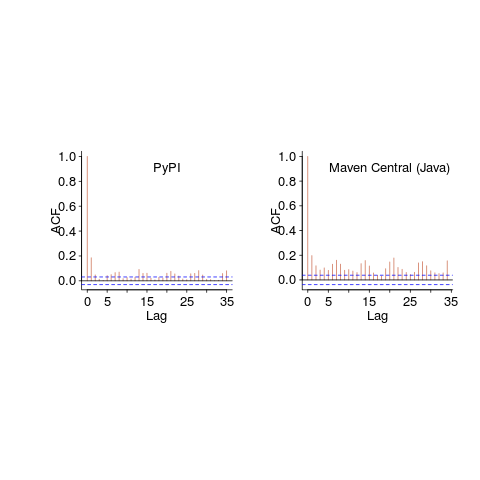
The recurring 7-day ‘peaks’ show the impact of weekends (I assume). Is the larger ”weekend-effect’ for Java, compared to PyPI, due to Java usage including a greater percentage of commercial developers (who tend not to work at the weekend)?
I did not manage to find any seasonal effect, e.g., more submissions during the winter than the summer. But I only checked a few of the languages, and only for a single peak (see code for details).
Another way of tracking package evolution is version numbering. For instance, how often do version numbers change, and which component, e.g., major/minor. There have been a couple of studies looking at particular repos over a few years, but nobody is yet recording broad coverage daily, over the long term 😉
Impact of function size on number of reported faults
Are longer functions more likely to contain more coding mistakes than shorter functions?
Well, yes. Longer functions contain more code, and the more code developers write the more mistakes they are likely to make.
But wait, the evidence shows that most reported faults occur in short functions.
This is true, at least in Java. It is also true that most of a Java program’s code appears in short methods (in C 50% of the code is contained in functions containing 114 or fewer lines, while in Java 50% of code is contained in methods containing 4 or fewer lines). It is to be expected that most reported faults appear in short functions. The plot below shows, left: the percentage of code contained in functions/methods containing a given number of lines, and right: the cumulative percentage of lines contained in functions/methods containing less than a given number of lines (code+data):

Does percentage of program source really explain all those reported faults in short methods/functions? Or are shorter functions more likely to contain more coding mistakes per line of code, than longer functions?
Reported faults per line of code is often referred to as: defect density.
If defect density was independent of function length, the plot of reported faults against function length (in lines of code) would be horizontal; red line below. If every function contained the same number of reported faults, the plotted line would have the form of the blue line below.
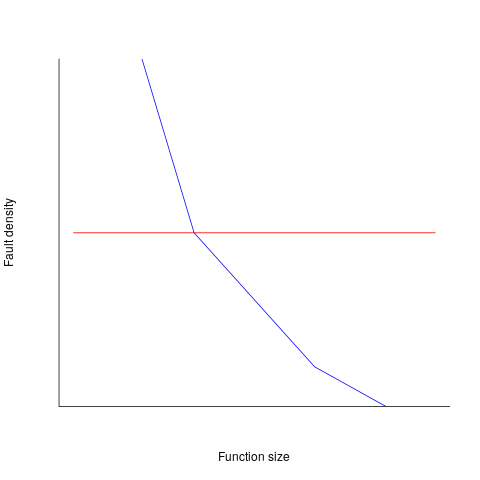
Two things need to occur for a fault to be experienced. A mistake has to appear in the code, and the code has to be executed with the ‘right’ input values.
Code that is never executed will never result in any fault reports.
In a function containing 100 lines of executable source code, say, 30 lines are rarely executed, they will not contribute as much to the final total number of reported faults as the other 70 lines.
How does the average percentage of executed LOC, in a function, vary with its length? I have been rummaging around looking for data to help answer this question, but so far without any luck (the llvm code coverage report is over all tests, rather than per test case). Pointers to such data very welcome.
Statement execution is controlled by if-statements, and around 17% of C source statements are if-statements. For functions containing between 1 and 10 executable statements, the percentage that don’t contain an if-statement is expected to be, respectively: 83, 69, 57, 47, 39, 33, 27, 23, 19, 16. Statements contained in shorter functions are more likely to be executed, providing more opportunities for any mistakes they contain to be triggered, generating a fault experience.
Longer functions contain more dependencies between the statements within the body, than shorter functions (I don’t have any data showing how much more). Dependencies create opportunities for making mistakes (there is data showing dependencies between files and classes is a source of mistakes).
The previous analysis makes a large assumption, that the mistake generating a fault experience is contained in one function. This is true for 70% of reported faults (in AspectJ).
What is the distribution of reported faults against function/method size? I don’t have this data (pointers to such data very welcome).
The plot below shows number of reported faults in C++ classes (not methods) containing a given number of lines (from a paper by Koru, Eman and Mathew; code+data):

It’s tempting to think that those three curved lines are each classes containing the same number of methods.
What is the conclusion? There is one good reason why shorter functions should have more reported faults, and another good’ish reason why longer functions should have more reported faults. Perhaps length is not important. We need more data before an answer is possible.
How are C functions different from Java methods?
According to the right plot below, most of the code in a C program resides in functions containing between 5-25 lines, while most of the code in Java programs resides in methods containing one line (code+data; data kindly supplied by Davy Landman):

The left plot shows the number of functions/methods containing a given number of lines, the right plot shows the total number of lines (as a percentage of all lines measured) contained in functions/methods of a given length (6.3 million functions and 17.6 million methods).
Perhaps all those 1-line Java methods are really complicated. In C, most lines contain a few tokens, as seen below (code+data):

I don’t have any characters/tokens per line data for Java.
Is Java code mostly getters and setters?
I wonder what pattern C++ will follow, i.e., C-like, Java-like, or something else? If you have data for other languages, please send me a copy.
Evolutionary pressures on C++, Java and Python
The future evolution of C++, Java and Python is being driven by very different interested parties, and it’s going to be interesting watching events unfold over the next 5-10 years.
I have previously written about how the C++ Standard’s committee is past its sell-by date, has taken off its ball and chain and is now in the hands of bored consultants.
Bjarne Stroustrup was once effectively treated as C++’s Benevolent Dictator For Life (during the production of the first C++ Standard some people were labeled as Bjarne groupees); things have moved on since then, but the ‘old-guard’ are trying to make a comeback. Suggesting that people ought to base their thinking on a book published almost 25-years ago (Stroustrup’s “The Design and Evolution of C++”; a very interesting book that is well worth reading) creates a rather backward looking image. Bored consultants are looking to work on exciting new ideas. The old-guard need to appear modern to attract followers (even if the ideas are old ideas with a fresh coat of paint).
The threat to C++ is from bored consultants, each adding their own pet idea to the language standard; a situation that Stroustrup thinks is starting to happen.
Java, the language, is owned by Oracle, the company (let’s not get too involved in exactly what they own, have copyright on, etc). Oracle are not shy about asking people for licensing fees. Java is now on a 6-month release cycle (at least the Oracle version, there are Open Source implementations) and the free support only applies to the current release; paying a license fee buys support for versions older than 6-months. In the short term, the cheapest solution is for companies to pay for support.
Oracle are always happy to send in the lawyers and if too many customers switch to non-Oracle implementations, I’m sure something can be found to introduce enough uncertainty to discourage work/distribution involving Open Source Java implementations.
Will Java survive Oracle’s licensing? It is not in their interest for Java to die; Oracle will adjust their terms to keep the money flowing in, but over the longer term I think willing Java developers are going to be hard to find.
Guido van Rossum recently removed himself from the post of Python’s Benevolent Dictator For Life. One of the jobs of a benevolent dictator is maintaining some degree of language coherence, which involves preventing people’s pet ideas from being added to the language. Does this mean that Python is slowly going to be become more and more bloated? Perhaps, but I think a more likely problem is a language fork, multiple implementations of slightly different (at first) languages all claiming to be Python.
These days, the strength of Python is its large collection of very useful, commercial grade, packages, and future language details may turn out to be irrelevant. There is a lot to learn from the Python 2/3 transition, but true believers like to think that things will turn out differently for them.
APIs can, for the time being, be copyrighted
There was an interesting turn of events in the Oracle vs. Google Java API lawsuit last friday. The original trial judge had ruled that an API are not copyrightable; last week the US federal Court of appeals reversed this decision, APIs are copyrightable. This legal battle is not over and the ruling can flip and flop its way up to the US supreme court, and not being a lawyer I’m happy to leave the legal discussion to others. Let’s assume that Oracle eventually win their Java API copyright claim, what does that mean for computer language usage and software developers?
If Oracle’s API copyright claim is upheld then they are potentially in line for a huge payout (Google might get to wiggle out of paying much via a fair use justification). I’m sure that some people will claim that this ‘win’ will kill off Java, even if this is true (I don’t think it is), what do the suits care? Give me a billion dollars and I will happily support the removal of any computer language from planet Earth.
In the early days of Android Google needed Java compatibility more than Java needed anything to do with Android. Now Android has such a commanding market share Google does not need to worry so much about Java compatibility. If Oracle had any interest in the future of Java they would be worried that this court case could result in Google switching the Android ecosystem to using a slightly incompatible Java-like language. In practice this court case is the only real opportunity for Oracle to make serious money from their Java intellectual property and they are not that excited about a steady stream of peanuts from future goings on.
What does Oracle winning the API copyright claim mean for developers?
If Google do launch a Java-like language then Java’s “write once run anywhere” mantra will be less true than it currently is (by avoiding a few traps and not straying too far from the well trodden path Java developers can create programs that are remarkable portable). In its market niche there is no other language that comes close to providing the kind of portability that Java offers, so existing users will be annoyed at having to worry about one more portability issue but are unlikely to jump ship.
The much more interesting question is the impact an Oracle win has on other companies producing products that include an API; they now have something to wave at competitors who have API-alike (I just made that word up) products. Any developer using an API that has its very own copyright discussion thread is likely to become a bit twitchy. The general result will be a cloud of uncertainty over some existing APIs from some providers.
Anybody introducing a new API will have to answer the ‘copyright’ question: “Do you claim copyright on your API?” In practice a very very small percentage of APIs ever get copied/cloned, because most fail or the competition comes up with what they think is a better API.
Would I care if a company claims copyright on its API and says it will sue anybody who copies/clones it? Obviously I have to use that API if it is the only way to get a job done, but what if I had a choice between it and a non-copyrighted API? I don’t think the question of copyright would be an issue for me, but I would be concerned if any company was being overly legalistic; do I really want to deal with a company more interested in legal matters than supporting developers? I think not.
Changes in the API/non-API method call ratio with program size
Amount of code is the fundamental metric of software engineering. How do things change as the amount of code changes and often just as interestingly what does not change with code size?
Most languages include some kind of base library functionality. Languages such as Java and C++ not only include a very large library but also a huge, widely used, collection of third-party libraries.
Let’s count every method call in lots of Java programs and for each program divide these calls into two groups, calls to methods in well-known libraries (call these the API methods) and all other method calls (i.e., calls to methods written by the developers who wrote each of the programs measured; call these the non-API methods).
I would expect the ratio of API to non-API method calls to be independent of program size.
Yes, the number of possible different API calls is fixed while the number of possible non-API calls increases with program size, but I don’t see why a changing ratio of unique calls should change the ratio of total calls.
Yes, larger programs are likely to contain more architectural stuff whose code is more likely to contain calls to non-API methods, but the percentage of architectural code is very small and unlikely to have much impact on the overall numbers.
The authors of the paper: Large-scale, AST-based API-usage analysis of open-source Java projects made their data available and so I got to check out my thinking 🙂
The plot below shows everything going to plan until around 10,000 method calls (about 50,000 lines of code). Why that sudden kink in the line (code and data)?
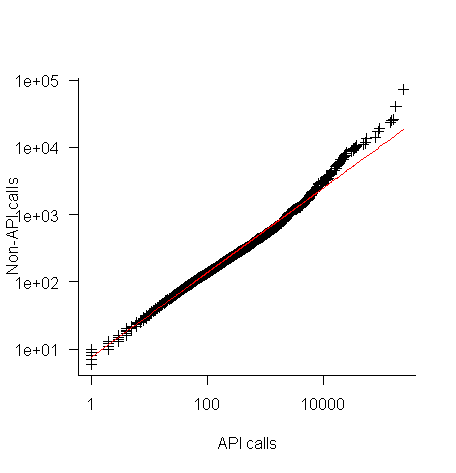
One possibility is that once a program gets to a size of around 50,000 lines the developers decide to invest in one or more wrapper packages which create a purpose built interface to an API (programs often have their own requirements and needs that existing an existing API interface does not quite meet); this would cause API calls to decrease and non-API calls to increase. If this pattern of usage occurred there would be a permanent change in the API/non-API ratio, and in practice the ratio change appears to be temporary.
I’m a bit stumped by this behavior. Suggestions on possible mechanisms welcome.
I wish I had the time to investigate, but I have a book to finish.
Agreement between code readability ratings given by students
I have previously written about how we know nothing about code readability and questioned how the information content of expressions might be calculated. Buse and Weimer ran a very interesting experiment that asked subjects to rate short code snippets for readability (somebody please rerun this experiment using professional software developers).
I’m interested in measuring how well different students subjects agree with each other (I have briefly written about this before).
Short answer: Very little agreement between individual pairs, good agreement between rankings aggregated by year.
The longer answer is below as another draft section from my book Empirical software engineering with R book. As always comments welcome. R code and data here.
Readability
Source code is often said to have an attribute known as
A study by Buse and Weimer <book Buse_08> asked Computer Science students to rate short snippets of Java source code on a scale of 1 to 5. Buse and Weimer then searched for correlations between these ratings and various source code attributes they obtained by measuring the snippets.
Humans hold diverse opinions, have fragmented knowledge and beliefs about many topics and vary in their cognitive abilities. Any study involving human evaluation that uses an open ended problem on which subjects have had little experience is likely to see a wide range of responses.
Readability is a very nebulous term and students are unlikely to have had much experience working with source code. A wide range of responses is to be expected and the analysis performed here aims to check the degree of readability rating agreement between the subjects.
Data
The data made available by Buse and Weimer are the ratings, on a scale of 1 to 5, given by 121 students to 100 snippets of source code. The student subjects were drawn from those taking first, second and third/fourth year Computer Science degree courses and postgraduates at the researchers’ University (17, 65, 31 and 8 subjects respectively).
The postgraduate data was not used in this analysis because of the small number of subjects.
The source of the code snippets is also available but not used in this analysis.
Is the data believable?
The subjects were not given any instructions on how to rate the code snippets for readability. Also we don’t know what outcome they were trying to achieve when rating, e.g., where they rating on the basis of how readable they personally found the snippets to be, or rating on the basis of the answer they would expect to give if they were being tested in an exam.
The subjects were students who are learning about software development and many of them are unlikely to have had any significant development experience outside of the teaching environment. Experience shows that students vary significantly in their ability to read and write source code and a non-trivial percentage do not go on to become software developers.
Because the subjects are at an early stage of learning about code it is to be expected that their opinions about readability will change while they are rating the 100 snippets. The study did not include multiple copies of some snippets, this would have enabled the consistency of individual subject responses to be estimated.
The results of many studies <book Annett_02> has shown that most subject ratings are based on an ordinal scale (i.e., there is no fixed relationship between the difference between a rating of 2 and 3 and a rating of 3 and 4), that some subjects are be overly generous or miserly in their rating and that without strict rating guidelines different subjects apply different criteria when making their judgements (which can result a subject providing a list of ratings that is inconsistent with every other subject).
Readability is one of those terms that developers use without having much idea what they and others are really referring to. The data from this study can at most be regarded as treating readability to be whatever each subject judges it to be.
Predictions made in advance
Is the readability rating given to code snippets consistent between different students on a computer science course?
The hypothesis is that the between student consistency of the readability rating given to code snippets improves as students progress through the years of attending computer science courses.
Applicable techniques
There are a variety of techniques for estimating rater agreement. <Krippendorff’s alpha> can be applied to ordinal ratings given by two or more raters and is used here.
Subjects do not have to give the same rating to share some degree of consistent response. Two subjects may share a similar pattern of increasing/decreasing/stay the same ratings across snippets. The <Spearman rank correlation> coefficient can be used to measure the correlation between the rank (i.e., relative value within sequence) of two sequences.
Results
When creating the snippets the researchers had no method of estimating what rating subjects would give to them and so there is no reason to expect a uniform distribution of rating values or any other kind of distribution of rating values.
The figure below is a boxplot of the rating of the first 50 code snippets rated by second year students and suggests that many subject ratings are within ±1 of each other.
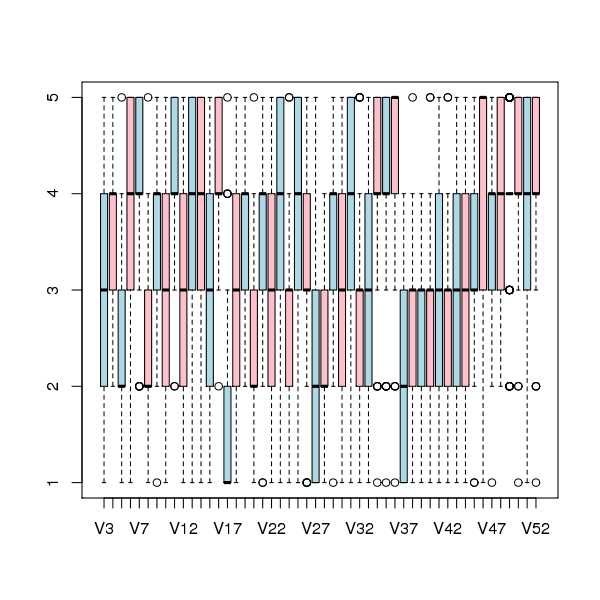
Figure 1. Boxplot of ratings given to snippets 1 to 50 by second year students (colors used to help distinguish boxplots for each snippet).
Between subject rating agreement
The Krippendorff alpha and mean Spearman rank correlation coefficient (the coefficient is calculated for every pair of subjects and the mean value taken) was obtained using the kripp.alpha and meanrho functions from the irr package (a <Jackknife> was used to obtain the following 95% confidence bounds):
Krippendorff's alpha cs1: 0.1225897 0.1483692 cs2: 0.2768906 0.2865904 cs4: 0.3245399 0.3405599 mean Spearman's rho cs1: 0.1844359 0.2167592 cs2: 0.3305273 0.3406769 cs4: 0.3651752 0.3813630 |
Taken as a whole there is a little of agreement. Perhaps there is greater consensus on the readability rating for a subset of the snippets. Recalculating using only using those snippets whose rated readability across all subjects, by year, has a standard deviation less than 1 (around 22, 51 and 62% of snippets respectively) shows some improvement in agreement:
Krippendorff's alpha cs1: 0.2139179 0.2493418 cs2: 0.3706919 0.3826060 cs4: 0.4386240 0.4542783 mean Spearman's rho cs1: 0.3033275 0.3485862 cs2: 0.4312944 0.4443740 cs4: 0.4868830 0.5034737 |
Between years comparison of ratings
The ratings from individual subjects is only available for one of their years at University. Aggregating the answers from all subjects in each year is one method of obtaining readability information that can be used to compare the opinions of students in different years.
How can subject ratings be aggregated to rank the 100 code snippets in order of what a combined group consider to be readability? The relatively large variation in mean value of the snippet ratings across subjects would result in wide confidence bounds for an aggregate based on ratings. Mapping each subject’s rating to a ranking removes the uncertainty caused by differences in mean subject ratings.
With 100 snippets assigned a rating between 1 and 5 by each subject there are going to be a lot of tied rankings. If, say, a subject gave 10 snippets a rating of 5 the procedure used is to assign them all the rank that is the mean of the ranks the 10 of them would have occupied if their ratings had been very slightly different, i.e., (1+2+3+4+5+6+7+8+9+10)/10 = 5.5. This process maps each students readability ratings to readability rankings, the next step is to aggregate these individual rankings.
The R_package[RankAggreg] package contains a variety of functions for aggregating a collection rankings to obtain a group ranking. However, these functions use the relative order of items in a vector to denote rank, and this form of data representations prevents them supporting ranked lists containing items having the same rank.
For this analysis a simple aggregate ranking algorithm using Borda’s method <book lin_10> was implemented. Borda’s method for creating an aggregate ranking operates on one item at a time, combining all of the subject ranks for that item into a single rank. Methods for combining ranks include taking their mean, their geometric mean and the square-root of the sum of their squares; the mean value was used for this analysis.
An aggregate ranking was created for subjects in years one, two and four and the plot below compares the ranking between 1st/2nd year students (left) and 2nd/4th year students (right). The order of the second year student snippet rankings have been sorted and the other year rankings for the snippets mapped to the corresponding position.
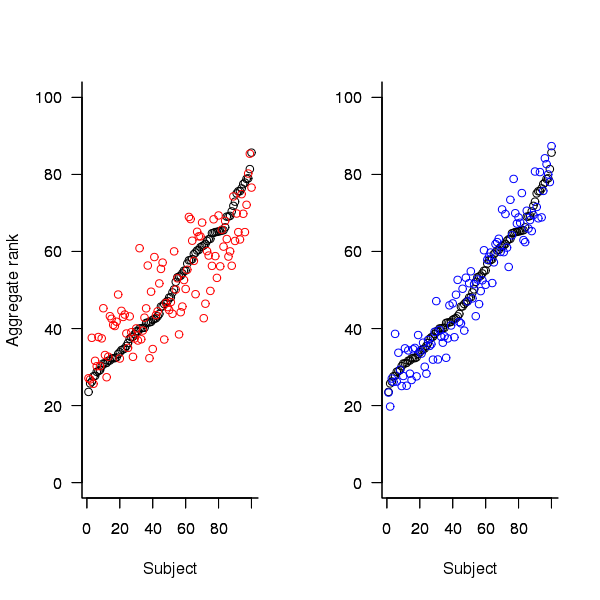
Figure 2. Aggregated ranking of snippets by subjects in years 1 and 2 (red and black) and years 2 and 4 (black and blue). Snippets have been sorted by year 2 ranking.
The above plot seems to show that at the aggregated year level there is much greater agreement between the 2nd/4th years than any other year pairing and measuring the correlation between each of the years using <Kendall’s tau>:
cs1.tau cs2.tau cs3.tau 0.6627602 0.6337914 0.8199636 |
confirms the greater agreement between this aggregate year pair.
Individual subject correlation to year aggregate ranking
To what extend to subject ratings correlate with their corresponding year aggregate? The following plot gives the correlation, using Kendall’s tau, between each subject and their corresponding year aggregate ranking.
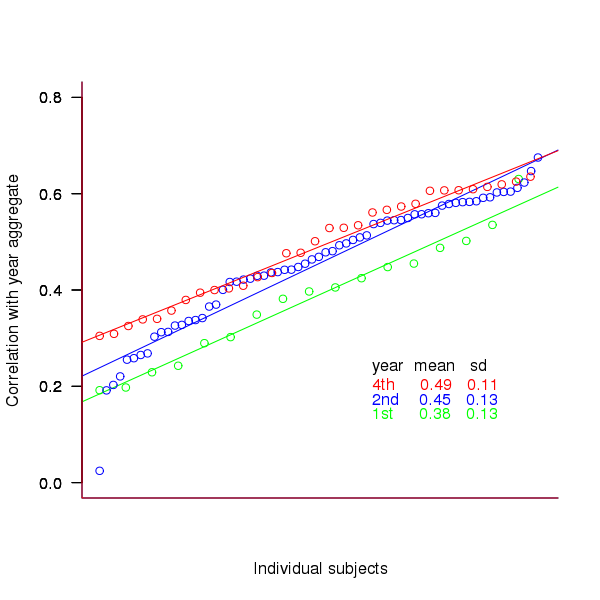
Figure 3. Correlation, using Kendall’s tau, between each subject and their corresponding year aggregate ranking.
The least squares fit shows that the variation in correlation across subjects in any year is very similar (removal of outliers in year 2 would make the lines almost parallel); the mean again shows a correlation that increases with year.
Discussion
The extent to which this study’s calculated values of rater agreement and correlation are considered worthy of further attention depends on the use to which the results will be put.
- From the perspective of trained raters the subject agreement in this study is very low and the rating have no further use.
- From the research perspective the results show that the concept of readability in the computer science student population has some non-zero substance to it that might be worth further study.
- From an overall perspective this study provides empirical evidence for a general lack of consensus on what constitutes readability.
It is not surprising that there is little agreement between student subjects on their readability rating, they are unlikely to have had much experience reading code and have not had any training in rating code for readability.
Professional developers will have spent years working with code and this experience is likely to have resulted in the creation of stable opinions on code readability. While developers usually work with code that is much longer than the few lines contained in the snippets used by Buse and Weimer, this experiment format is easy to administer and supports a fine level of control, i.e., allows a small set of source attributes of interest to be presented while excluding those not of interest. Repeating this study using such people as subjects would show whether this experience results in convergence to general agreement on the readability rating of code.
Summary of findings
The agreement between students readability ratings, for short snippets of code, improves as the students progress through course years 1 to 4 of a computer science degree.
While there is very good aggregated group agreement on the relative ranking of the readability of code snippets there is very little agreement between pairs of individuals.
- Two students chosen at random from within a year will have a low Spearman rank correlation coefficient for their rating of code snippet readability.
- Taken as a yearly aggregate there is a high degree of agreement between years two and four and less, but still good agreement between year 1 and other years.
- There is a broad range of correlations, from poor to good, between year aggregates and student subjects in the corresponding year.
Undefined behavior is a design decision
Every few years or so some group of people in the C/C++ community start writing about the constructs specified as having undefined behavior in those languages. A topic that always seems to be skipped is why a language committee would choose to specify that the behavior in a particular case was undefined.
A quick refresher for readers on the definition of Undefined behavior, from the C Standard: “behavior, upon use of a nonportable or erroneous program construct or of erroneous data, for which this International Standard imposes no requirements”. The two key features are that the behavior applies when an error has occurred and any behavior whatsoever is permitted after one of these errors occurs. Examples of constructs that have undefined behavior are divide by zero, the result of an arithmetic operation on a signed value not being representable in its type (i.e., overflowing) and indexing an array outside of its defined bounds.
The point to note about all undefined behaviors is that the C/C++ language committee could have chosen to specify the behavior that a conforming implementation is required to support. Some language specifications do attempt to explicitly define the behavior for all constructs, e.g., Java, while other languages have a smaller set of undefined behaviors (e.g., Ada, which uses the term Bounded error instead of undefined behavior; there are 35 of them in Ada 2005). To understand why languages take these different approaches we need to look at the language design aims.
The design aims of C included it being implementable for any processor and for the generated code to be efficient (I’m not sure to what extent these might still be major design aims for C++). Computing systems come in all shapes and sizes, some with hundreds of bytes of memory and others with gigabytes, some raise exceptions when certain operations occur while others set processor status flags and others don’t do anything special.
A willingness to accept whatever behavior happens to occur, in an error situation, is the price that has to be paid for efficient execution on a wide range of disparate processors. The C/C++ designers were willing to pay this price while while the Java designers were not, with the Ada designers willing to tolerate less variability than C/C++.
Undefined behavior need not be nasty behavior, an implementation could chose to generate a helpful message or try to recover from it.
There are C tools and compilers (when certain options are specified) that check, at runtime, for various kinds of undefined behavior. I am in the minority in having Boundschecker installed as my default C compiler (as the name suggests it checks that array and pointer accesses to an object are within the defined bounds); for reasons I don’t understand few C/C++ developers are willing to use tools like this. For production code I use a non-boundschecking compiler; I don’t know whether Ada programs are tested with the mandated bounds checking switched on and then have it switched off for the production version (this is what Pascal developers do, in my experience). Of course Java developers have no choice but to permanently live with checking turned on.
The number of companies that make a living selling runtime checking tools is a small percentage of the number of companies based on selling static analysis tools. There continues to be a steady stream of runtime checking tools appearing and quickly disappearing, but until a developers start being sent to jail for faults in their code I don’t foresee the market growing.
Optimizations to figure out when code need not be generated to perform a bounds check because the access is known to be within bounds is an active research area. These days the performance penalty is not so much executing the checking instructions but the disruption to the instruction pipeline caused by the branches that might be taken (if the bounds check fails).
The cost of all the checking required by Java is that the minimal permitted configuration requires at least 256K of memory (Oracle’s K virtual machine, used by the Java Micro Edition which is intended for embedded systems, also makes floating-point optional and allows implementations some freedom in how some constructs are handled). So the Java motto really out to be “Write once, run anywhere with at least 256K and don’t depend on floating-point”.
I have heard stories of Ada code being liberally scattered with various forms of unchecked (how the developer tells the compiler not to do any runtime checking) but have not seen any empirical analysis (a study of goto usage in Ada did not have any trouble finding plenty of uses to analyze).
Recent Comments